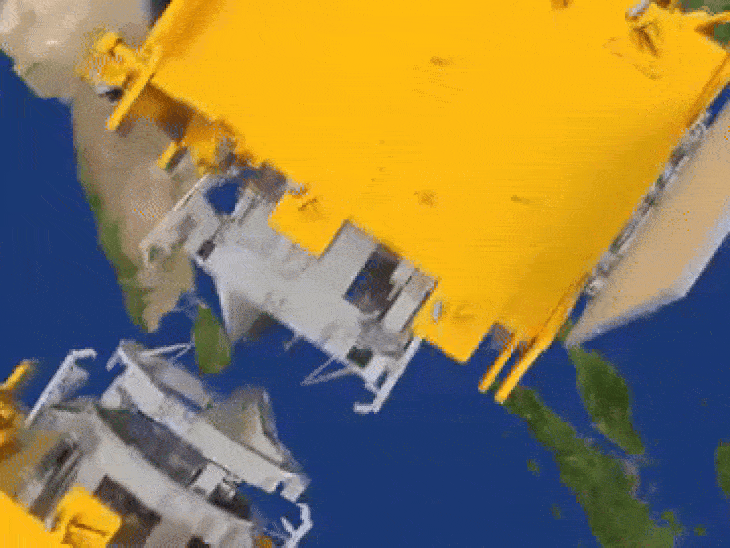This is an animation of two spaceships connecting in space. It was published by ISRO.
India has become the fourth country to successfully dock two spacecraft in space. Before that, only Russia, America and China had achieved this. ISRO said the docking experiment was completed on the morning of January 16.
Missions like Chandrayaan-4, Gaganyaan and the Indian Space Station depended on the success of this mission. Samples of lunar soil will be brought to Earth as part of the Chandrayaan-4 mission. In the Gaganyaan mission, humans will be sent into space.
ISRO had launched the Space Docking Experiment mission on December 30, 2024 at 10 pm from the Satish Dhawan Space Center in Sriharikota. In this context, two spacecraft were deployed 470 km above the Earth with the PSLV-C60 rocket.
The two spacecraft were scheduled to connect on this mission on January 7, but it was postponed. Then, on January 9, the docking was also postponed due to technical problems. On January 12, after bringing the spacecraft 3 meters closer, they were returned to a safe distance.
Before going further into the news, 4 photos of the mission…
PSLV-C60 rocket ready on the launch pad before the SpaceX mission launch.
The Spadex mission was launched on December 30, 2024 at 10 p.m. from Sriharikota.
ISRO deployed the two spacecraft 470 km above Earth.
The spacecraft was docked after moving 15 meters closer and then 3 meters closer.
After successful docking, ISRO said:
Spaceship docking successfully completed! A historic moment. Let’s know the docking process: the distance between spaceships has been reduced from 15 meters to 3 meters. Docking was initiated accurately, resulting in the successful capture of the spacecraft. Docking completed successfully. India has become the fourth country to successfully dock in space. Congratulations to the whole team! Congratulations India! After docking, control of both spacecraft as a single object was successful. Undocking and power transfer checks will be carried out in the coming days.
What was the goal of the Spacex mission: to show the world docking and undocking technology
Demonstrate the technology of docking and undocking two small spacecraft in low Earth orbit. Demonstrate the technology of transferring electrical energy between two docked spacecraft. Space docking means joining or connecting two spacecraft in space.
Spacex Mission Process: Learn How the Two Spacecraft Got Closer
On December 30, two small spacecraft, Target and Chaser, were launched into different orbits at an altitude of 470 km by a PSLV-C60 rocket.
After deployment, the speed of the two spacecraft reached about 28,800 kilometers per hour. This speed was 10 times the speed of the bullet.
There was no direct communications link between the two spacecraft. These were guided from the ground. The two spaceships were brought closer together.
Laser range finders have been used to determine distances between 5 km and 0.25 km. A mooring camera was used for a range of 300 m to 1 m. While visual cameras have been used at distances of 1 meter to 0 meters.
After successful docking, the transfer of electrical energy between the two spacecraft will be demonstrated in the coming days. Then the spacecraft will undock and both will begin operating their respective payloads. This will continue to provide valuable data for approximately two years.
Why the mission is necessary: The success of missions like Chandrayaan-4 depends on it
The technology will be used in the Chandrayaan-4 mission in which samples will be brought back to Earth from the Moon. Docking technology will also be needed to build a space station and then travel there. This technology is also necessary for the Gaganyaan mission. in which humans will be sent into space. This technology is necessary for satellite maintenance, interplanetary missions and sending humans to the moon.
India has filed a patent on its docking mechanism. This docking mechanism was named “Indian Docking System”. ISRO has also filed a patent on this docking system. India had to develop its own docking mechanism, as no space agency shares the details of this extremely complex process.
24 payloads were also sent on the mission for microgravity experiments. These payloads were part of the fourth stage of the PSLV rocket called POEM (PSLV Orbital Experimental Module). 14 payloads are from ISRO and 10 payloads are from Non-Government Entities (NGE).
America first docked on March 16, 1966
The first docking of two spacecraft in space took place on March 16, 1966, as part of the Gemini VIII mission. The Gemini VIII spacecraft docked with the Agena target vehicle, which had been launched earlier the same day. The Soviet Union (now Russia) first docked two spacecraft in space on October 30, 1967. The unmanned Kosmos 186 and 188 were then automatically docked. This docking was an important step in the Soviet Union’s return to flight program. China’s first space docking took place on November 2, 2011, when the uncrewed Shenzhou 8 spacecraft successfully docked with the Tiangong-1 space laboratory module. Docking took place at the Jiuquan Satellite Launch Center in Gansu, China.

